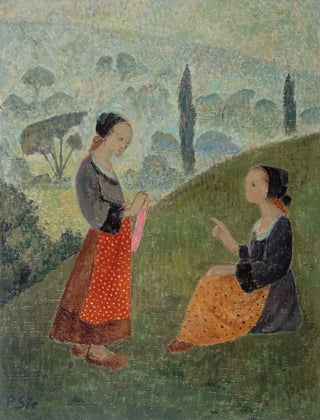Art print | Morning Mists - Paul Sérusier


View from behind

Frame (optional)
In the fascinating universe of art, certain works stand out for their ability to evoke deep emotions and intimate reflections. "Brumes du matin - Paul Sérusier" is one of those creations that, through its visual poetry, transports the viewer to a world where reality and imagination meet. This piece, imbued with a delicate atmosphere, invites silent contemplation, where shades of color and shapes intertwine to form an almost dreamlike landscape. Through this art print, the artist manages to capture the magic of a fleeting moment, the one when daylight begins to pierce the morning mists, revealing the ephemeral beauty of nature.
Style and uniqueness of the work
Paul Sérusier's style is deeply rooted in the post-impressionist movement, but he transcends conventions to offer a unique vision of his era. "Brumes du matin" is characterized by a palette of soft colors and brushstrokes that seem to dance across the canvas. The composition is both harmonious and dynamic, creating a subtle balance between abstraction and figuration. The shapes blend into each other, while pastel shades evoke an atmosphere of serenity and mystery. Sérusier, through this work, succeeds in expressing an impression of light and movement, making palpable the sensation of a nascent morning. This innovative approach to color and light marked an important step in the evolution of modern art, making him a pioneer of plein air painting.
The artist and his influence
Paul Sérusier, an emblematic figure of the Pont-Aven School, established himself as a major artist of the late 19th century. A student of Paul Gauguin, he was influenced by his master's innovative ideas, particularly regarding the use of color and the simplification of forms. Sérusier was also an active member of the Nabi movement, which advocated a symbolic and spiritual approach to art. His work "Brumes du matin" perfectly illustrates this quest for inner truth, where each color and shape are chosen not only for their representation but also for

Matte finish

View from behind

Frame (optional)
In the fascinating universe of art, certain works stand out for their ability to evoke deep emotions and intimate reflections. "Brumes du matin - Paul Sérusier" is one of those creations that, through its visual poetry, transports the viewer to a world where reality and imagination meet. This piece, imbued with a delicate atmosphere, invites silent contemplation, where shades of color and shapes intertwine to form an almost dreamlike landscape. Through this art print, the artist manages to capture the magic of a fleeting moment, the one when daylight begins to pierce the morning mists, revealing the ephemeral beauty of nature.
Style and uniqueness of the work
Paul Sérusier's style is deeply rooted in the post-impressionist movement, but he transcends conventions to offer a unique vision of his era. "Brumes du matin" is characterized by a palette of soft colors and brushstrokes that seem to dance across the canvas. The composition is both harmonious and dynamic, creating a subtle balance between abstraction and figuration. The shapes blend into each other, while pastel shades evoke an atmosphere of serenity and mystery. Sérusier, through this work, succeeds in expressing an impression of light and movement, making palpable the sensation of a nascent morning. This innovative approach to color and light marked an important step in the evolution of modern art, making him a pioneer of plein air painting.
The artist and his influence
Paul Sérusier, an emblematic figure of the Pont-Aven School, established himself as a major artist of the late 19th century. A student of Paul Gauguin, he was influenced by his master's innovative ideas, particularly regarding the use of color and the simplification of forms. Sérusier was also an active member of the Nabi movement, which advocated a symbolic and spiritual approach to art. His work "Brumes du matin" perfectly illustrates this quest for inner truth, where each color and shape are chosen not only for their representation but also for






